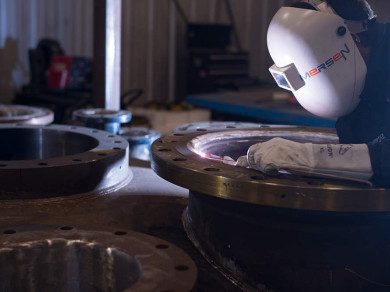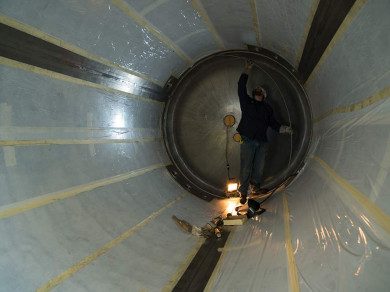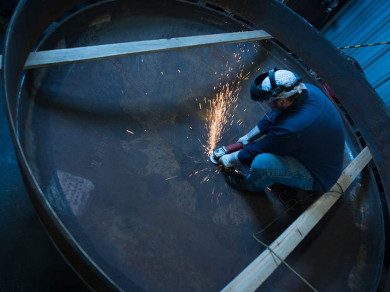Tantalum, reactive and refractory metal
Tantalum is both reactive and a refractory metal and can be welded under a protective atmosphere. A thin layer of tantalum oxide at its surface ensures outstanding corrosion resistance against ultra-corrosive and oxidizing chemicals including concentrated sulfuric acid, free chlorine or free bromine amongst others.
Tantalum heat exchangers, pressures vessels, reactors and columns are used in ultra-corrosive and oxidizing applications, for example with concentrated sulfuric acid, nitric acid, free chlorine or free bromine
Tantalum
Tantalum is a soft, weldable, refractory, and reactive metal with a melting temperature of 2996°C
PROPERTIES OF TANTALUM
| Atomic number | 73 |
| CAS number | >7440-25-7 |
| Atomic mass | 180.95 |
| Melting point | 2 996°C |
| Boiling point | 5 458 °C |
| Atomic volume | 0.0180 nm3 |
| Density at 20°C | 16.65 g/cm3 |
CORROSION RESISTANCE OF TANTALUM
When exposed to air, tantalum forms a very dense oxide layer (Ta2O5) which protects the base material from corrosion. This oxide layer therefore makes tantalum corrosion-resistant against hydrochloric acid, hydrobromic acid, sulfuric acid, nitric acid, free chlorine, free bromine, among many other chemicals
Tantalum has a limited corrosion resistance against bases and reducing media. It is not resistant against fluorides.
CORROSION RESISTANCE TO WATER, AQUEOUS SOLUTIONS AND NON-METALS
| Water | Hot water < 150 °C | resistant |
| Inorganic acids | Hydrochloric acid < 30 % up to 190 °C Sulfuric acid < 98 % up to 190 °C Nitric acid < 65 % up to 190 °C Hydrofluoric acid < 60 % Phosphoric acid < 85 % up to 150 °C |
resistant resistant resistant not resistant resistant |
| Organic acids | Acetic acid < 100 % up to 150 °C Oxalic acid < 10 % up to 100 °C Lactic acid < 85 % up to 150 °C Tartaric acid < 20 % up to 150 °C |
resistant resistant resistant resistant |
| Lyes | Sodium hydroxide < 5 % up to 100 °C Potassium hydroxide < 5 % up to 100 °C Ammonia solutions < 17 % up to 50 °C Sodium carbonate < 20 % up to 100 °C |
resistant resistant resistant resistant |
| Saline solutions | Ammonium chloride < 150 °C Calcium chloride < 150 °C Ferric chloride < 150 °C Potassium chlorate < 150 °C Body fluids < 150 °C Magnesium sulfate < 150 °C Sodium nitrate < 150 °C Tin chloride < 150 °C |
resistant resistant resistant resistant resistant resistant resistant resistant |
| Non-metals | Fluorine Chlorine < 150 °C Bromine < 150 °C Iodine < 150 °C Sulfur < 150 °C Phosphorous < 150 °C Boron < 1 000 °C |
not resistant resistant resistant resistant resistant resistant resistant |
TANTALUM WELDING, THE KEY STEP
Thanks to its high level of ductility, tantalum is especially suitable for forming processes such as bending, stamping, or pressing.
Tantalum is welded by TIG. Extreme care is required to ensure that all surfaces, which due to the heat of welding reach temperatures above 300°C, are shielded with inert gas. Helium, argon, or a mixture of these two gases provides an atmosphere that prevents embrittlement by absorption of oxygen, nitrogen, or hydrogen into the heated metal. In the presence of a pure, inert atmosphere, the fusion and adjacent area will remain ductile. The duration of the weld should be kept as short as possible to avoid excessive external heating. Heated surfaces should be protected by appropriate gas shielding which cools the parts, limits the heat zone, and excludes air from the heat zone.
Tantalum process equipment operate in ultra-corrosive or oxidizing environments. There is no room for compromise. They must be flawless.
Contact USA
Sales & Engineering
Salem, VA 24153
(540) 389-7535
Contact USA
Sales & Engineering
Salem, VA 24153
(540) 389-7535








